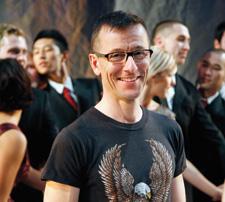
COLLABORATION. Christopher House has run TDT since 1994; the company turns 40 this year.
Obviously Christopher House loves to move. At 53 the queer choreographer and artistic director of Toronto Dance Theatre (TDT) still dances almost every day in addition to practising pilates and cycling his surprisingly well-toned ass around the city. The results of his labours are evident to anyone watching him rehearse with the company of twenty-something dancers, both for how capable he is at demonstrating moves to them, as well as for the abdominal ripple that occasionally peaks out from under his T-shirt. “I’m in good shape because I’m interested in being physically active,” he says, with a shrug. “It’s something that’s important to me so I manage to find time to move almost every single day.”
The year 2008 marks the 40th anniversary of TDT. It’s also House’s 30th year with the company and his 14th as artistic director. His newest dance work Dis/(sol/ve)r, which opens at the newly renamed Fleck Dance Theatre this week, features the company’s five male and four female dancers dressed in formal attire in a space suggestive of a ballroom, moving to an original score by Phil Strong. The dancers form partnerships and love relationships, only to evaporate from each other’s arms again and again. “I wanted to explore the ways in which people dissolve from our lives,” House says. “Sometimes it’s dying. Sometimes it’s fading into memory. Sometimes it’s just moving away from each other emotionally.”
Born and raised in St John’s, Newfoundland, House made his first major move at the age of 19 when he bid goodbye to The Rock and set sail for our nation’s capital to attend the University of Ottawa, studying philosophy and political science. As a budding homo with a drive to learn more about the world House knew he couldn’t stay in familiar territory. “St John’s is certainly more fun now than it was 30 years ago,” he says. “But at that point there was no alternative scene and a lot of homophobia. I knew that in order to become the person I wanted to be I needed to live in a bigger city.” Though he was met with greater social acceptance and a broader cross section of personalities in Ottawa, in an ironic twist he actually found the city less interesting in certain ways. “It was odd how strangely innocent Ottawa felt to me, especially considering where I came from,” he says. “In Ottawa everything shut down at 5pm. St John’s actually had a more vibrant nightlife.”
Toward the end of his degree House got the first taste of his future career when he signed up for a couple of courses in the dance department. “I think part of why I was attracted to dance was because I recognized that there was a queer community there where I would be comfortable,” he says. “Coming from the political science department where everyone wanted to be a lawyer it was really amazing to be around people who were interested in different kinds of ideas, different sets of politics and different values in their lives.”
By the time he finished his degree at 21, House knew without a doubt that dance was his future, so he did what every other aspiring dancer in the world did in 1977: He packed his bags and plunked down cash for a one-way ticket to New York. “At that time in New York it felt like every second person was a dancer,” he says, laughing. “On the subway everyone was carrying a dance bag. There were three weekly publications devoted to dance. New York was becoming the centre of the dance world and if you weren’t there, you weren’t part of it.”
So aside from dance, were there any other interesting things happening then? Sex, drugs and punk rock, perhaps? House laughs. “It was a pretty intense time in New York for a lot of reasons,” he says. “The punk scene was exploding and the sex scene was still incredibly open. To say that anything went at that point is probably an understatement.” Indeed in pre-AIDS-era New York gay sex culture was most definitely at its peak. Bars like Man’s Country, the Spur and of course the infamous SM club the Mine Shaft saw homos from across the globe come together to fuck with abandon. House stresses that his focus at the time was on becoming a successful dance artist. But surely he found one or two occasions to dabble in the seedy side of life? “Oh, I definitely got laid!” he laughs, “but I was still pretty shy at that point, so I didn’t really throw myself into the whole sex scene. Even for the limited amount that I was part of it, it’s still just luck that I didn’t end up dead.”
Luck may in fact have been the only thing that saved House from the untimely demise met by so many of his compatriots. The AIDS epidemic, which kicked in a few years later, ravaged the entire arts community; the dance world was particularly hard hit. “So many people from that era died,” he says quietly, staring down. “So much of what New York built up for the dance world, AIDS tore down.”
After a year House decided to leave NYC, finding it difficult to make ends meet, despite the fact that his rent was less than $200 a month. “I didn’t have the street smarts to make it in New York,” he says. “Even though it was still really cheap to live there at that point I didn’t have enough money to train as much as I wanted.” After returning to Ottawa for a brief stint, House landed in Toronto by accident, where he would end up spending the next 32 years of his life. “So many Newfoundlanders have a hate-on for Toronto that I’d never really thought about living there,” he says. “I just went there to visit a friend and ended up auditioning for the dance program at York University on a whim.”
House was accepted to the program, where he continued his training as well as getting his first taste of choreographing. In 1978 House started as a dancer at Toronto Dance Theatre, the company founded 10 years prior by Peter Randazzo, Patricia Beatty and David Earle. House became resident choreographer in 1981. In 1994 he took the helm as the company’s artistic director. His dynamic dance works have met with critical acclaim both in Toronto and around the world.
Still, there are grumblings among some younger members of the dance community that he should bring his tenure with the company to a close and let someone new take the reins. “I can understand why some people might think that,” he says. “The reason I’m still with the company is because I’m still learning new things with my work there. The company is completely different than it was five years ago, not just in who the dancers are, but in the ways that we approach the work and the kinds of questions we’re asking.” With much of his recent repertoire, like Dis/(sol/ve)r, House puts a great deal of emphasis on process and creating works collaboratively with his dancers.
“When I stop learning new things with my work there, it’ll be time to move on,” says House. “Until then though, I’m staying right where I am.”
Dis/(sol/ve)r is danced by Kaitlin Standeven, Brodie Stevenson, Kamen Wang, Linnea Wong, Matt Waldie, Sarah Wasik, Luke Garwood, Yuichiro Inoue and Alana Elmer. For more on the company go to Tdt.org.


 Why you can trust Xtra
Why you can trust Xtra


